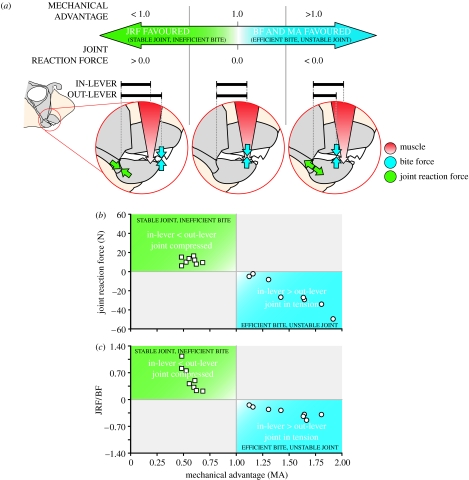Figure 7.
(a) Graded arrow represents the trade-off between the stability of the jaw joint and the efficiency of force transfer from the jaw adductor musculature to prey as a function of MA. When MA is less than 1.0 (left inset of the jaws of H. colliei), less than 100% of the muscular force is transmitted as bite force (BF) and the jaw joint is stabilized (favoured) via compressive JRF. When MA is greater than 1.0 (right inset), bite force exceeds the adductive muscular force via force amplification of the mandibular lever system. However, the prey item acts as a temporary fulcrum about which the lower jaw rotates, resulting in tensile JRF that destabilize the joint. When MA is 1.0 (centre inset), the lower jaw is in static equilibrium and JRF do not occur. (b) Magnitude and orientation of JRF in H. colliei as a function of MA. (c) Ratio of joint reaction force to bite force as a function of MA in H. colliei. As MA increases to 1.0, more of the adductive muscular force is transferred to the prey (increasing bite force) and less force must be balanced at the jaw joint, resulting in low ratios. When MA is greater than 1.0, bite force exceeds the adductive muscular force and the difference of these forces must be balanced at the jaw joint. In either case, low ratios indicate reduced joint loading. In (b, c) positive values indicate joint-stabilizing compressive forces that occur when MA is less than 1.0, whereas negative values indicate joint-destabilizing tensile forces that occur when MA is greater than 1.0 (squares, anterior; circles, posterior).

